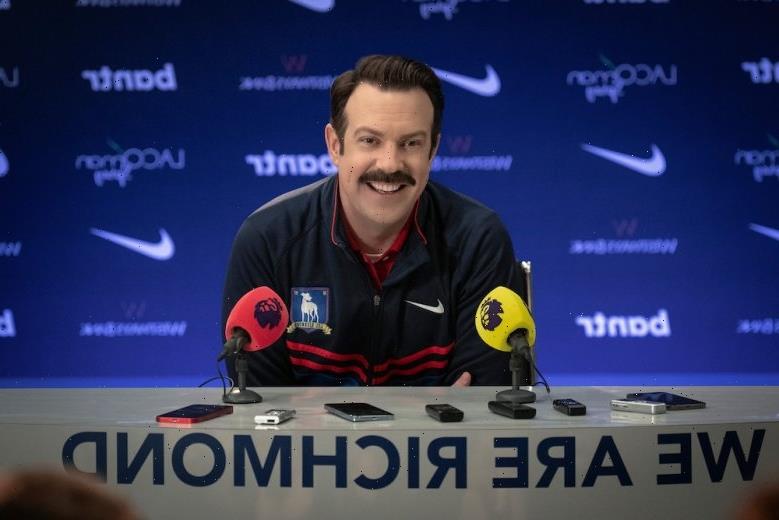Ted Lasso is a mess. From the first frame of Season 3 through its fourth episode (the last provided for review), Jason Sudeikis’ upbeat football coach is adrift, downtrodden, and asking for help. His wife and son remain 4,000 miles away. His panic attacks haven’t magically dissipated, though he is receiving treatment from Dr. Fieldstone (Sarah Niles). But the nagging concern for the perpetually unbothered optimist is a bit bigger than any one thing. It’s a question both familiar to everyone and specific to an individual; a question broader than a simple answer can provide, yet one that often requires decisive action to settle.
Ted wants to know why he’s here. When Coach Beard (Brendan Hunt), his wizened sounding board, asks whether Ted means “here” as in London or “here” as in “here on this Earth,” Ted narrows it down a bit: Why am I in London? Why am I coaching AFC Richmond? Why am I choosing to be in a foreign land, away from my family, if I don’t have to be? As we learned in past seasons, Ted took the job because he and his wife, Michelle (Andrea Anders), needed space to figure out if their marriage was salvageable, and they’ve since decided it isn’t. Spending time away while working an all-consuming job is one way to process heartbreak and start over, but Ted is still a father. He wants to be there for Henry, and how can he be there for his son when he’s here in London?
While everyone loves Ted and wants him to be happy, no one wants to hear him cast doubt on what he’s doing — and that goes double for “Ted Lasso.” Just as the loving colleagues, friends, and players surrounding Ted don’t want to think about him going back to Kansas, fans of the Apple TV+ hit would prefer that their favorite show sticks around a bit longer than three seasons. Much has been said in the nearly two-year break between Seasons 2 and 3 about the series’ future, but no official decision has been announced. Unlike the upcoming premieres of “Succession” and “Barry” — two award-winning programs that dealt with lingering buzz about endings by confirming their impending finales — “Ted Lasso” debuts what could be its final season without assurances either way.
If this is goodbye, it would help explain Ted’s early doubts… and a few pesky choices to open Season 3. The first four episodes range from 44-50 minutes, a length that bogs down the comedy’s crisp pacing while hamstringing a few character turns. Some scenes could be excised to save time, others just need a little trimming, but even if you’re on board with the super-sized entries — the second season’s last four episodes are all 42-49 minutes each — Season 3 isn’t as dialed into each of its personal arcs as past editions. There’s a lack of context to certain relationships that could have used an extra polish (even though it seems they’re banking on a big reveal down the line), and some characters just seem like different people from one hour to the next.
Without getting into spoilers, Season 3 picks up within a few months of the second season’s finale. Ted’s soul-searching is prompted by his son’s visit to London (or, more specifically, the end of that visit). Keeley (Juno Temple) is working 24/7 at her new PR firm, KJPR (which sounds like a radio station), while Roy (Brett Goldstein) is trying to step up his coaching game after Nate (Nick Mohammed) left to coach West Ham United. His heel turn, courtesy of Rupert (Anthony Head) purchasing AFC Richmond’s new rival, remains a focal point, as Roy, Coach Beard, and particularly Rebecca (Hannah Waddingham) aren’t about to let go of their grudge.
Audiences may not either. Nate’s betrayal rubbed certain viewers the wrong way — whether it was deemed too obvious, too abrupt, or simply too mean — and much of his motivation rested on his big outburst with Ted: that the chipper coach made Nate feel special, only to turn around and neglect him. Hurt people hurt people, as they say, and Nate’s disproportionate outrage stemmed from a slight amplified by social media and personal insecurities. While Ted tried to make amends, Nate has spurned them, and Season 3 sees their one-sided rivalry deepen in ways both predictable and uneven. Rather than let Nate settle into his slightest point-of-view, he’s a man split in two: kindly buying the staff lunch one day and coldly berating his players as dumb-dumbs the next.


Juno Temple and Hannah Waddingham in “Ted Lasso”
Courtesy of Colin Hutton / Apple TV+
Other characters lack a similar clarity, but that’s not to say “Ted Lasso” is a mess. It’s easy for audiences (and critics) to conflate messy situations with storytelling mistakes — the most notable recent example being “Babylon,” a film built from near-constant chaos without ever losing focus on why — but the aforementioned hiccups in Season 3’s rollout don’t damper its spirit. Roy’s frosty exterior endures (and is still good for regular laughs), just as his vulnerable interior swells, and Season 3 wisely pairs him with Jamie (Phil Tartt), whose narcissistic tendencies have softened as his maturation continues. (Tartt is the one performer in a routinely heralded cast who’s still, somehow, underrated.) Keeley is a bit reserved, her status slightly opaque, but Temple’s embodiment of those traits only draws you in. Sam Obisanya (Toheeb Jimoh) remains the best, Rebecca veers toward a redundant arc, but Waddingham pulls her back with aplomb, and the suspense generated by the team’s performance continues to surprise in minor moments that add up to many satisfying matches.
And Ted, in all his glorious mess, holds it all together. Few characters can reference “Twin Peaks” and Hallmark movies without straining credulity — who would watch both? and who would watch enough of both to be able to name-drop each at a moment’s notice? — yet Ted has always walked a near-impossible tightrope. Benevolent to the point of angelic and cheery to the point of exhaustion, what keeps our titular lead grounded (and affable) is Sudeikis’ evolving portrayal. In Season 1, he made us believe such a man could exist (on TV, if not beyond). In Season 2, he let us peek behind the curtain to better appreciate Ted’s day-to-day reality.
Throughout Season 3, Sudeikis holds firm to that first shot, when Ted’s atypically unkempt appearance is paired with a pensive dolor. He’s a raw nerve, as tender as he can get. While Ted’s existential quandary doesn’t keep him from spreading joy — his curious, beaming smile is so omnipresent you might think his mustache would fall off if the corners of his mouth weren’t there to prop it up — but underneath, he’s wrestling with big questions: how to feel about what’s happened with Nate, how to feel about his family situation (which is sure to make this year’s discourse unbearable), and how to feel about his responsibilities in general.
Still, I don’t expect Ted to snap or break or crumble. I expect him to sort it out, honestly and persuasively — and I expect the show to do the same. There’s a comfort to believing in Ted, just as there’s a comfort to watching “Ted.” And even if you fear the question being asked, that doesn’t mean the answer will disappoint.
Grade: B
“Ted Lasso” Season 3 premieres Wednesday, March 15 with one episode. New episodes will be released weekly.
Source: Read Full Article


